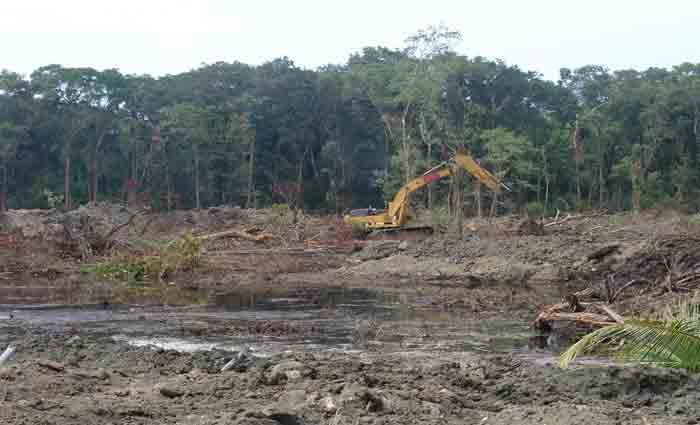Queensland land clearing is undermining Australia’s environmental progress
Land clearing has returned to Queensland in a big way. After we expressed concern that policy changes since 2012 would lead to a resurgence in clearing of native vegetation, this outcome was confirmed by government figures released late last year.
It is now clear that land clearing is accelerating in Queensland. The new data confirm that 296,000 hectares of bushland was cleared in 2013-14 – three times as much as in 2008-09 – mainly for conversion to pastures. These losses do not include the well-publicised clearing permitted by the government of nearly 900 square kilometres at two properties, Olive Vale and Strathmore, which commenced in 2015.
The increases in land clearing are across the board. They include losses of over 100,000 hectares of old-growth habitats, as well as the destruction of “high-value regrowth” – the advanced regeneration of endangered ecosystems.
These ecosystems have already been reduced to less than 10% of their original extent, and their recovery relies on allowing this regrowth to mature.
Alarmingly, our analysis of where the recent clearing has occurred reveals that even “of concern” and “endangered” remnant ecosystems are being lost at much higher rates now than before.
While this level of vegetation loss and damage continues apace, Australia’s environmental programs will fall well short of achieving their aims.
Neutralising our environmental programs
Land clearing affects all Australians, not just Queenslanders. Australia spends hundreds of millions of dollars each year trying to redress past environmental damage from land clearing. Tens of thousands of volunteers dedicate their time, money and land to the effort.
But despite undeniable local benefits of such programs, their contribution to national environmental goals is undone, sometimes many times over, by the damage being done in Queensland.
Take the federal government’s 20 million trees program. At a cost of A$50 million, it aims to replace 20 million trees by 2020 to redress some of the damage from past land clearing.
Yet just one year of increased land clearing in Queensland has already removed many more trees than will be painstakingly planted during the entire program.
The Australian government’s Emissions Reduction Fund (ERF) is paying billions of dollars to reduce carbon emissions from industry. But the carbon released from Queensland’s land clearing in 2012-2014 alone is estimated at 63 million tonnes, far more than was purchased under the first round of the ERF (at a cost to taxpayers of A$660 million).
Species cannot recover if their habitat is being destroyed faster than it is being restored. But under Caring for our Country and Biodiversity Fund grants, the extent of tree planting to restore habitat across Australia reported since 2013 is just over 42,000 hectares - an order of magnitude less than what was cleared in Queensland alone in just two years.
And it will be many decades before these new plantings will provide anything like the environmental benefits of mature native vegetation.
Land clearing between 2012 and 2014 in Queensland is estimated to have wiped out more than 40,000 hectares of koala habitat, as well as habitat for over 200 other threatened species. Clearing, along with drought (which is also made worse by clearing), is the major cause of an 50% decline in koalas of south-west and central Queensland since 1996.
The loss of remnant habitat, especially from forests along waterways, means more habitat fragmentation. This is a further threat to many species of wildlife, and it hampers our ability to adapt to a rapidly changing climate.
The federal government has committed hundreds of millions of dollars to improve reef water quality. Yet ongoing land clearing in reef-draining catchments will reverse many of the gains these programs aim to achieve. Last year, Queensland’s Auditor-General reported that stronger legislation would be essential to reducing harmful catchment runoff to the Great Barrier Reef.
Prevention is better than cure
We live in an era of tightening carbon budgets, declining land-production capacity and rapidly deteriorating biodiversity, including in iconic places such as Great Barrier Reef. The evidence is clear that we cannot continue to degrade our environment without severe consequences.
It is far more efficient to prevent environmental damage than to try to reverse it later.
For example, the cost of stabilising river-banks following deforestation can range from A$16,000 to A$5 million per kilometre. Natural ecosystems contribute enormously to the economy in ways that are often unrecognised.
We are running up a large environmental debt that will eventually have to be paid by all Australians, one way or another.
And some damage, like the loss of a species, is irreversible.
Previous native vegetation laws had successfully reduced land clearing, but were reversed in 2013 by the former Newman government.
The current Palaszczuk government in Queensland has repeated its election promise to re-strengthen native vegetation protections. The amendment bill is due to be introduced to parliament within weeks.
But the minority government relies on the votes of cross-benchers to pass its legislation–so for now, the future of some of Australia’s most precious environmental assets remains uncertain.
ssociate professor of Environmental Management, The University of Queensland, Bill Laurance is distinguished research professor and Australian Laureate, James Cook University, Bob Pressey is professor and Program Leader, Conservation Planning, ARC Centre of Excellence for Coral Reef Studies, James Cook University, Carla P. Catterall is professor in ecology and environment, Griffith University, enior research Fellow in Ecology, The University of Queensland, irector ARC Centre of Excellence for Environmental Decisions, The University of Queensland, James Watson is associate professor, The University of Queensland, ssociate Professor, The University of Queensland, ssociate professor and ARC Future Fellow, The University of Queensland, Marc Hockings is professor of Environmental Management, The University of Queensland. All are authors for The Conversation.
